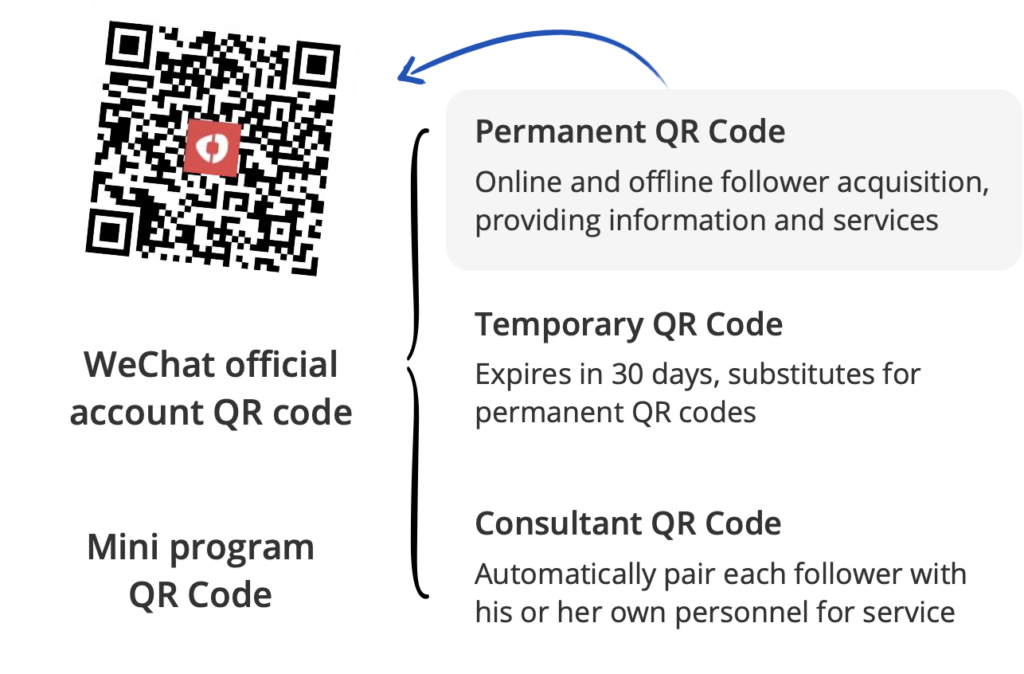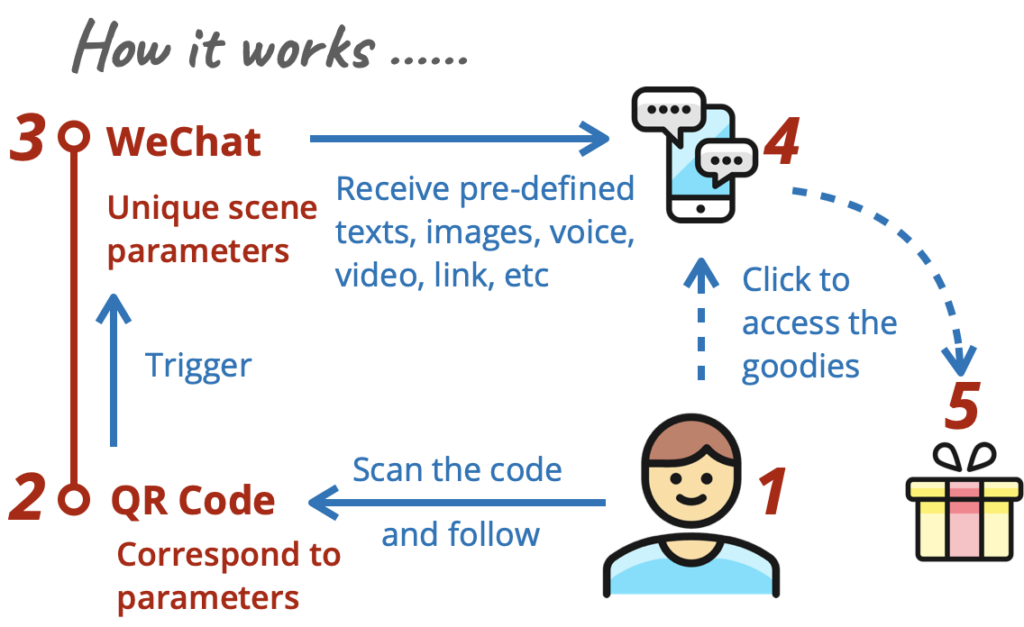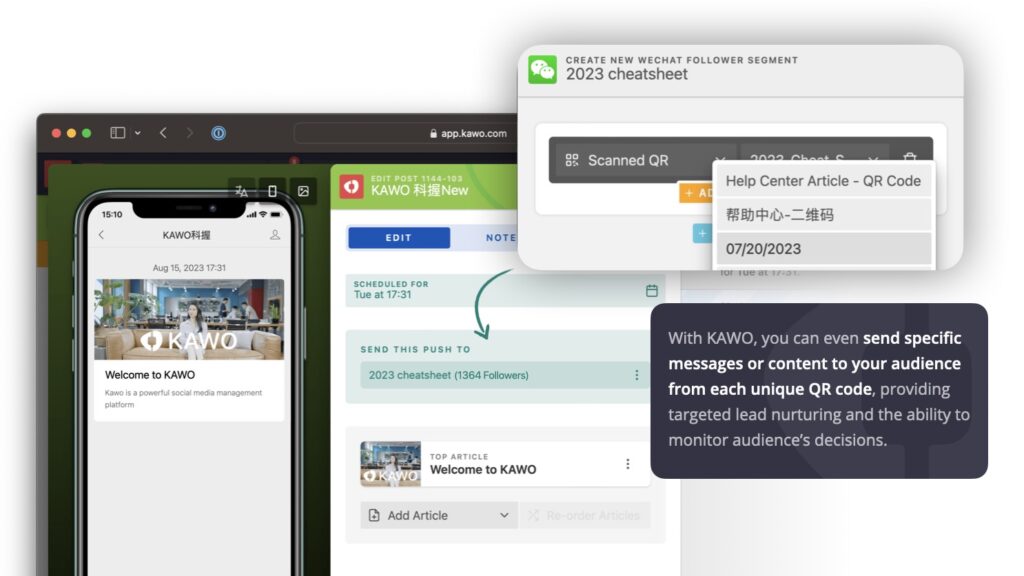Top-of-funnel performance is usually hard to track and measure. That’s why we need to take advantage of unique QR codes to better categorize sources where followers come from to find the most loyal audience.
A QR code is essentially a unique URL link stored in a graphic, which can be scanned and read by smartphones. It’s a convenient and secure way to access information and services online, often used in payment, account following, targeted communications, etc.

*Most QR code actions happen in WeChat. Therefore we use WeChat as an example.
How to Find and Measure the Right Source?
Let’s say a beauty brand kicked off two campaigns: One is about free giveaways of sample products, and the other one is about a partnership with a KOL sharing beauty tips. After respective audiences scan the unique QR code of each campaign to gain access to the giveaway, marketers can monitor their unfollowing decisions: Do they just accept the value and leave or do they stay, and for how long? When the account pushes new content, are they still willing to be there and listen? It’ll help you gain insights into your followers’ behaviors.

With KAWO, you can even send specific messages or content to your audience from each unique QR code, providing targeted lead nurturing and the ability to monitor audience’s decisions. Request a Demo to Learn More…

When Vanity Metrics Go Wrong
Focusing on follower numbers alone (or any metrics alone for that matter) provides few meaningful marketing insights, and potentially could incentivize fake data to prevail, putting a brand’s long-term growth in jeopardy.
Potential risks of buying fake data include but are not limited to:
1. Reduce trust from the audience
2. Destroy partnership/collaboration opportunity
3. Compromise accuracy for data analysis
4. Become vulnerable to potential legal hassles
……
Even so, the presence of fake data on social media has been tenacious. What are the incentives behind it? How do people who use it deal with the drawbacks? We interviewed someone with firsthand experience to share her insights with us.

What’s the incentive behind buying fake followers/impressions/engagement?
We call these “fake volumes.” They are a “kick-start” for our new accounts or new campaigns at the earlier stage. It’s the quickest way to make sure the platform recognizes us and puts us into the bigger traffic pool so that we are exposed to more potential audiences.
Is organic content or paid content not enough for you? Do you have to buy fake volumes?
Unfortunately, we have to sometimes …… owned content takes time to see results and paid content is usually expensive. When you’re under pressure to deliver within a limited budget and time, you start considering more options. Is it healthy? Of course not, but sometimes it’s very difficult to compete and survive in this fast-paced market… When everyone is getting ahead with this method and you don’t (do it), you will be left behind.
This is also part of the reason why we don’t use agencies for content creation. I’m not sure how much I trust their benchmarks or results.
However, please don’t get me wrong, the quality of content is always important, no matter the circumstances. Let’s say that some users are attracted to your account due to your impressive follower or engagement number. However, if your future content doesn’t meet their expectations, they will leave with no hesitation.
If getting an audience to stay or convert is your destination, quality content would be the toll station, and buying “fake volumes” is essentially driving on a carpool lane when the traffic is slow — it could get you there sooner, but you still have to pay the toll fee like everyone else, and probably pay more if you get caught.
What are the risks?
We only buy “fake volumes” in 2 scenarios: a short period after opening a new account or the first 2 to 3 hours after a content push, mainly the first one. You could buy it from the platform itself, but it’s so notorious that everyone scoffs at it. We don’t want to deal with that.
We usually buy from a 3rd party. I got a reference from a trusted marketer friend. The price was CNY 63 for every 1000 reads/view, and CNY 40 for every 100 fans including engagement — it might be more expensive now.
The time for bots is in the past. All the “fake volumes” we bought were from real people. We can discuss and design their online behaviors, and they just follow suit (including controlling the percentage between impressions and engagements). They know how each platform’s algorithm works, and we never buy in a large amount, so we have never triggered any alert. However, we were very cautious with comments because they are hard to fake and the real audience can always tell.
As for the brand’s reputation: it’s not that serious if we don’t do it for the long-term and we do it carefully, but it is exhausting.
Is it difficult to analyze data with all these fake volumes?
It’s possible. However, we are able to calculate the data accurately because we know how much and when we bought the fake volumes. For example, if it happens in the first 3 hours, we just discard the engagement data during that time slot.
What role does your boss play in this issue?
My boss doesn’t know all the details, sometimes they agree to do something only because they trusts someone or they wants to take a chance … but most employees are smart enough to avoid risky actions that could potentially destroy the company’s reputation and his or her own. When the boss asks for a specific target for metrics, usually followers, I won’t argue if it’s not too out of line, because maybe he just wants to impress his family, friends or investors, but if it’s too much, I’d either do a thorough research and give a reasonable benchmark, or just explain the situation and be honest that I’m not capable enough to commit a perfect crime.
What do you think the future of fake data will be?
It’s the bandwagon effect. Honestly, it happens everywhere, domestically or abroad, but the difference is that the overseas market is more mature and people have a sense of responsibility and a platform to voice out or regulate these actions, but the Chinese market is still developing. Everyone tends to mind their own business, so there is room for these types of actions…
However, no matter which market, consumers are smart, over time these low-level tricks will be rendered obsolete by the natural selection of the market.
KAWO Enterprise API guarantees the accuracy and security of your account data. Arrange a demo to learn more.







